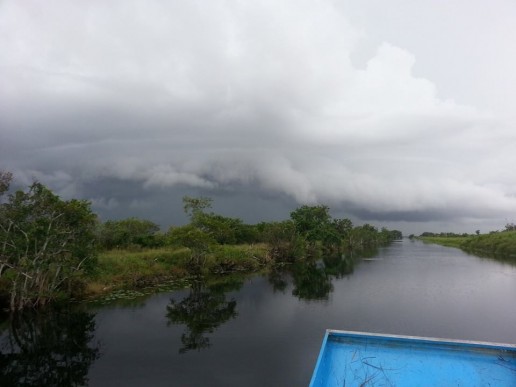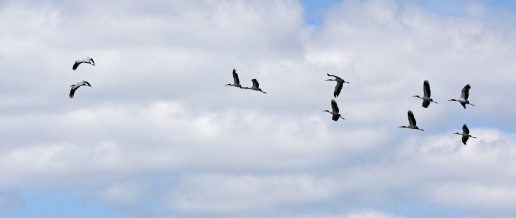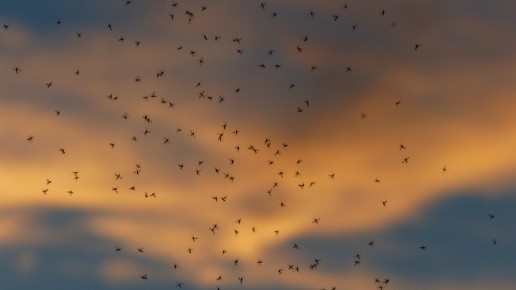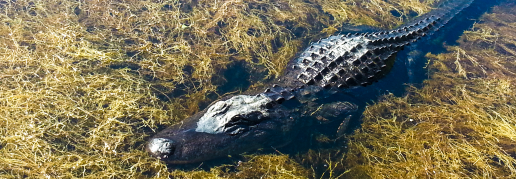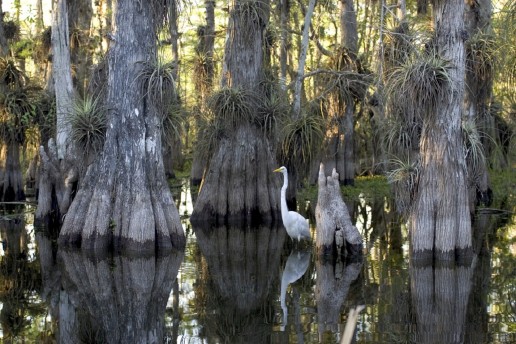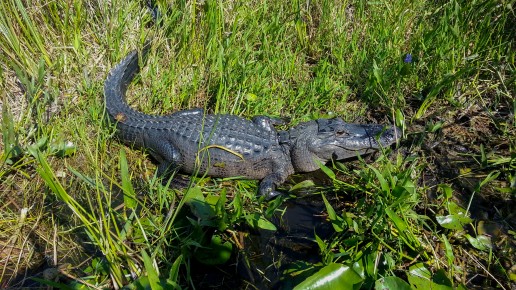Hurricane Irma Update
Just two weeks ago, much of Florida witnessed the power of mother nature when Hurricane Irma made its landfall. Despite being spared the widespread devastation seen by the Florida Keys, South Florida took its licks, too. However, Mack’s Fish Camp is still standing!
As of this past weekend, we finally have power back, but have still been offering airboat rides during the outage. Not only were we still standing, but up and running as well. That’s right, we have still been running private airboat tours and offering our bass fishing guide service in the Everglades. In fact, our airboats have made for formidable leaf blowers, helping us with clearing much of the foliage.
Like much of South Florida, our trees sustained the heaviest damage. But our old structures are still intact, including our home, for which we are very grateful. Looking at the devastation experienced by people in Texas and the Keys, we feel blessed to still have our home and each other.
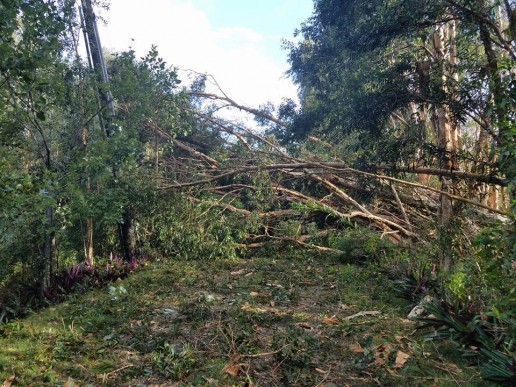
No storm can take down Gladesmen Culture
As a family of Gladesmen, we thrive in times like these through our toughness, tenacity, and a bond that no wind can uproot! But as a small, family-owned business, Mack’s has stayed alive through word-of-mouth, and we sure could use some now.
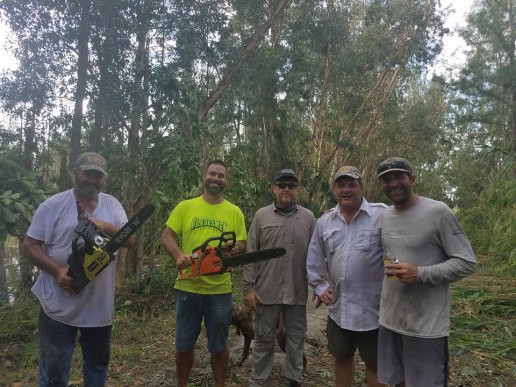
We took a hit with this storm. So, now we’re looking to you: our friends, family, and fans, to spread the word about this little piece of heaven we call home. Recommend us to a friend who’s never seen the Everglades, or bring them out here with you for an airboat ride.
Or even if you’re just curious to see the result of the awesome power of nature against its otherwise calm beauty, come pay us a visit. Rest assured that as long as the Florida Everglades are around, you can bet us Gladesmen will be, too!
Wildlife Profile: Spiders in the Everglades
Spiders probably aren’t the first animal that comes to mind when you think of the Florida Everglades. But they are among the most abundant of Everglades wildlife, with 20,000 spiders for each of the 2 million acres here. Most of them go about their business unseen, and many are too small to be seen!
Spiders in the Everglades can be found hiding in the underbrush or are easily spotted by the webs they make in trees. Spiders are arachnids, not insects, so they all have eight legs instead of six, no antennae, and their bodies are divided into segments.
As scary as they look to some people, most spiders aren’t a threat to us, and only some are venomous. In fact, spiders are a cherished part of the Everglades food web, feeding on nuisance insects. Here are some species of spider you may spot on an Everglades tour at Mack’s Fish Camp.
Banana Spiders
Banana spiders are the species you’re most likely to see when you visit the Everglades. While the males are smaller and more dark-colored, the more colorful females measure three inches long, and are among the biggest spiders in North America.
These spiders are a type of orbweaver, and spin large circular webs to catch prey. A female’s web is made of golden silk similar to its color, and is three feet long. They feed on insects of all sizes, from mosquitoes to dragonflies. Banana spiders aren’t aggressive, and their bite isn’t harmful to humans.
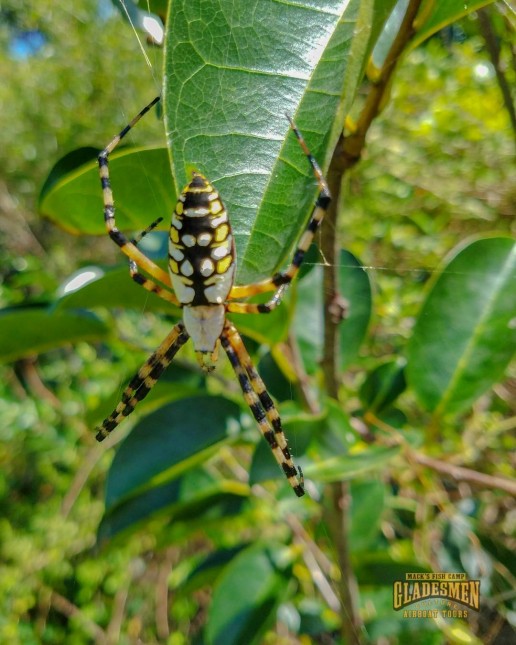
Fishing Spider (dolomedes triton)
This aquatic spider species spends nearly all of its time floating on or near water. In fact, fishing spiders can walk on the water’s surface and even dive underwater to catch prey. They hunt insects, tadpoles, even fish by sensing vibrations in the water, and then eat on dry land. Fishing spiders are dark gray to brown-colored, with two pale lines running the length of their bodies. Because the Everglades is a mostly aquatic ecosystem, fishing spiders are right at home in the sawgrass marshes and wet prairies.
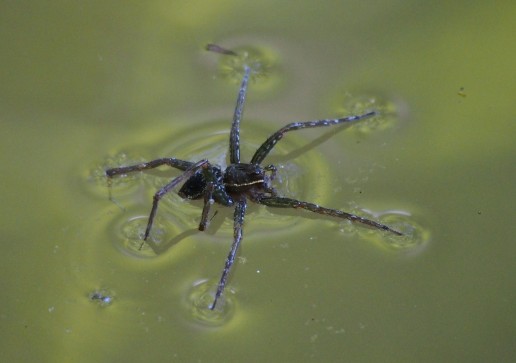
Red Widow
The red widow spider is a venomous spider with an orange-red body and a black abdomen with red spots. They’re fairly large, reaching 1.5 inches in length. Unlike its cousin, the black widow, it hasn’t been known to have ever bitten a person. However, they are known to have very potent venom. Red widows are endemic to Florida, found in the pine scrubs and pine rocklands. They make their nests in saw and scrub palmetto plants, and feed on large insects like crickets.
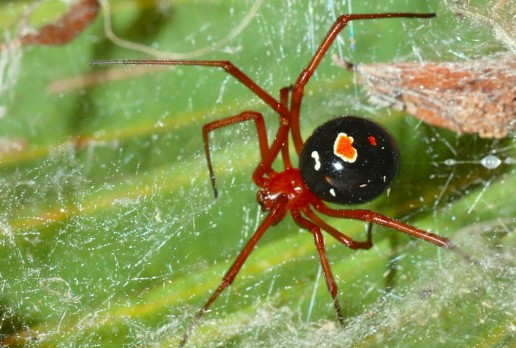
Brown Recluse
The brown recluse is one of the most venomous spiders in the Everglades, with venom as strong as the black widow’s. These quarter-sized arachnids not only make their webs, but seek out prey on the ground, such as cockroaches. Brown recluse spiders are not aggressive, and reports of them biting humans are rare. But they will bite if pressed up against someone’s skin, by leaning into one or when putting on clothing. Although, the strength of their bite varies, it can cause skin damage, loss of limb, and death.
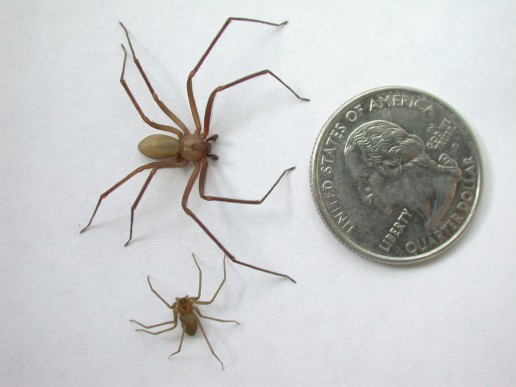
Crab Spiders
These small spiders are named for how they move by scuttling sideways, as a crab would. Most species are dark grey to black to camouflage themselves. Other species are brightly colored to hide inside flowers, wait to ambush their prey. Crab spiders do not spin webs to catch or wrap their prey, but feed immediately after attacking.
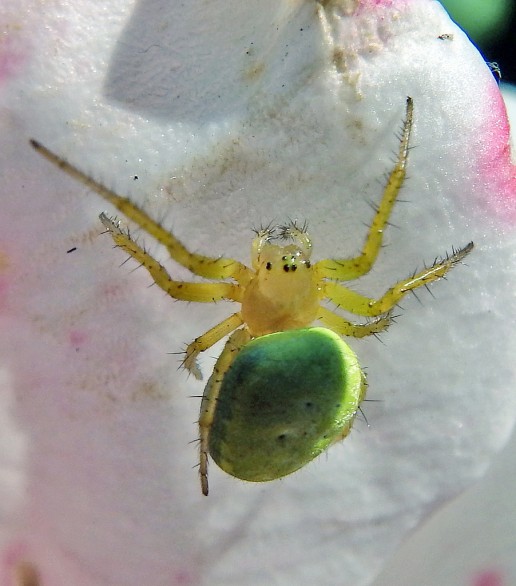
Spot Everglades Wildlife on an Airboat Ride
Spiders in the Everglades serve their role in this ecosystem, no matter how frightening of beautiful you might find them. On a private airboat tour at Mack’s Fish Camp, you’ll get to see them and many other Everglades wildlife species.
5 Ways Hurricanes Can Affect Everglades Wildlife
The arrival of September means the beginning of the end of summer. But for Florida, and several other southern states, it signifies the peak of Atlantic Hurricane season. Hurricane season lasts from June 1st until December 1st, with the most activity usually occurring between late August and mid-October.
Because Florida is a narrow peninsula, The Everglades can feel the effects of a direct hit by a hurricane. Unfortunately, the Everglades wildlife and ecosystem can feel the brunt of the storm as strongly as humans can.
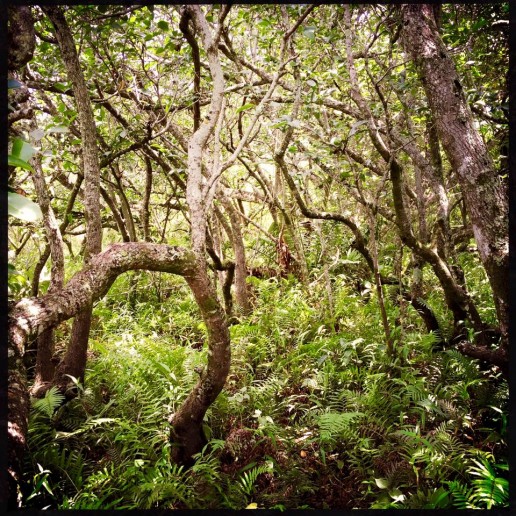
Heavy Rains Can Cause Freshwater Floods
Large amounts of rainfall from hurricanes can flood river basins near coastal areas. The excess water carried along these watersheds could surge into saltwater estuaries. This can offset the balance of saltwater and freshwater, and hurt the ecosystem of the coastal Everglades habitat.
Saltwater Intrusion Caused by Storm Surge
Hurricane winds can be so strong that they cause coastal water to surge far past the shoreline. Along with the flooding damage, the saltwater carried inland can harm freshwater wetland areas. Plants and animals aren’t as salt-tolerant in freshwater marshes and estuaries, and can suffer damage if the seawater doesn’t drain quickly.
High Windspeeds Can Destroy Tree Habitats
Everglades wildlife have specific niches in the diverse habitats here. Powerful hurricane winds can damage hammocks and forests, which not only destroys the animals’ homes, but their food as well. The potent wind gusts can strip berries and nuts from trees.
Storm Winds Can Dislocate Wildlife
The powerful wind fields contained in hurricanes can push birds hundreds of miles off course and far away from their habitats. Some birds get trapped inside the eye of these tropical cyclones, and held there by the extreme winds until it dissipates. Marine mammals like manatees can be blown onshore, too.
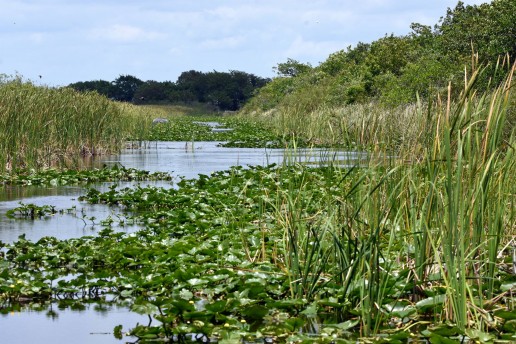
Rough Seas and Storm Winds Harm Marine Wildlife
Storm surge, combined with the rough seas caused by strong winds, are a direct threat to aquatic life. In 1992, Hurricane Andrew killed 182 million fish in the Everglades basin, and nearly 10 million more fish in the waters offshore of Louisiana.
As harsh as Mother Nature can seem to the creatures that live in the Florida Everglades. But, understand that these animals were here long before people, and have adapted to endure all kinds of peril. Taking an airboat eco tour lets you see the varieties of Everglades wildlife that thrive here, much like the tradition of Gladesmen Culture that has been here for generations.
Tips to Spot Everglades Wildlife on an Airboat Tour
The Florida Everglades is filled with an impressive variety of wildlife, including birds, reptiles, and even mammals. You may spot many animals out in the open, and some hiding in the sawgrass while taking an Everglades airboat tour in Miami. But there are a few things to do and consider before taking an airboat ride that will help your chances.
Consider the Time of Year
Everglades Birdwatching
Over 350 species of birds have been sighted in the Everglades. The largest and most diverse concentration of birds occurs here during Everglades dry season, from December through mid-May. The cooler air brings in migratory birds like bluebirds from the north, and even tropical birds like Flamingos from the Caribbean. The lower water levels of the dry season help local wading birds like the Great Blue Heron and Roseate spoonbill nest and raise their young.
But, we can’t forget the most famous species of Everglades wildlife…
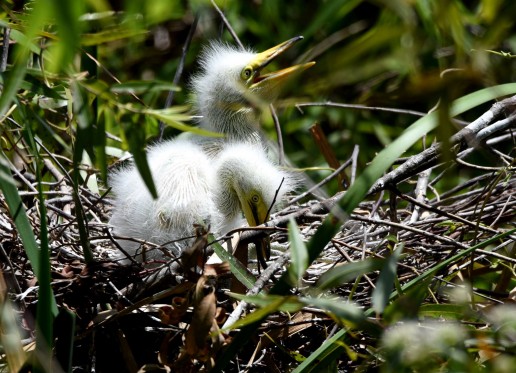
Best Time to Spot Everglades Alligators
Alligators often prefer the cooler temperatures of the dry season, but are active for much of the year. Alligator mating season in the Everglades lasts from mid-April through May, followed by nesting season from June and July. By August, you’ll see baby alligators swimming and hear their tiny roars coming from the sawgrass.
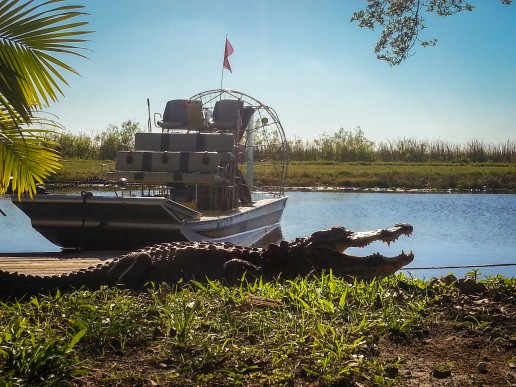
Become Familiar with Everglades Wildlife
When you take an Everglades airboat tour in Miami, you will be guided be true blue Gladesmen that are very knowledgeable of Everglades wildlife. They can help you identify animals and answer questions you might have about them. But, if you do a little studying on the animals you’d like to see beforehand, you can spot them on your airboat ride more easily.
Consider the Temperature
With average temperatures in the 80’s or higher, the summer in South Florida can get very hot, especially for the animals. Summer temperatures can also stretch into late spring and early fall, too.
Like Florida’s human residents, most animals spend much of the day trying to keep cool and avoid the sun. As a result, many birds and other Everglades wildlife are most active in the morning and early afternoon during the summertime.
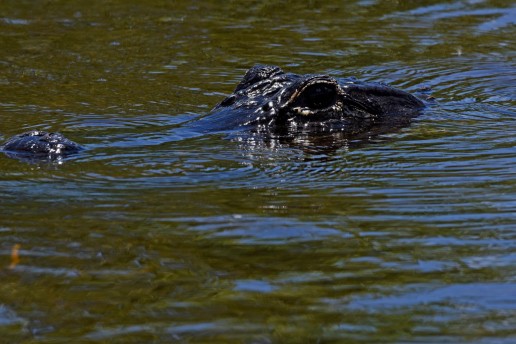
Keep a Lookout for Movement
Alligators can spend a lot of time in the water, and can be so still they’re often mistake for logs! That ripple you just saw in the water might not have been a large mouth bass. Wading birds like egrets and herons also stalk their prey so slowly that you can miss them standing by the cat tails and sawgrass.
And keep an eye out for color differences of objects you see against each other. Birds can’t be sneaky and pretty at the same time if you’re watching closely!
As incredible as the Everglades are, the biodiversity of this ecosystem makes it even more unique. It’s a sure bet that you’ll see a good number of animals while airboating in Miami. Make sure to keep an eye out for them, and remember that timing is everything!
Keep the season and time of day in mind when planning your Everglades trip. But no matter when you take your airboat ride at Mack’s Fish Camp, you’ll get to see these animals up close and in their natural habitat.
Islands on The River of Grass: Everglades Tree Islands
There is a common misconception that the Florida Everglades is just a giant, grassy swamp. It’s actually made of several different habitats, each full of distinct flora, including trees. When you visit the Everglades, you’ll notice many clusters of trees standing tall against the wet prairie and sawgrass marsh. These small hammocks are known as Everglades tree islands.
What Are Tree Islands?
Tree islands are small forests that sit on land just dry enough for them to take root. But, there’s more to it than that. Everglades tree islands are formed on land that is elevated just slightly, in some cases only by inches!
They can be made of tropical hardwood trees, ferns, cypress, and other topical plant species. Before the Everglades were drained in the 1920’s, the freshwater sheetflow went around the tree islands. As a result, many of them have an elongated, teardrop shape, with the rounded end pointed toward the water flow.
A Shelter for Everglades Wildlife
Being the only spots of dry earth outside of the pine rocklands and hardwood hammocks, tree islands can act as a dry oasis for Everglades wildlife. Reptiles, birds, and mammals that feed in the wet prairie use them for shelter to rest or hide from predators.
Many birds, including the Everglades snail kite, nest on these islands. White tailed deer also frequent them, because if they spend too much time in water they can develop hoof rot, which can be fatal.
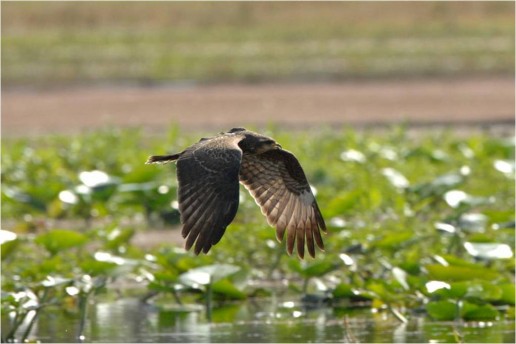
Where Did They Come From?
The ground that Everglades tree islands rest on was long-believed to be bedrock that slowly rose over time. It was recently revealed by a team of scientists that these spots were middens, garbage piles from centuries-old human settlements. The researchers found bones, shell tools, and charcoal, which would’ve helped create an elevated dry area where plants could grow.
The phosphates from the bones acted as fertilizer, and the roots reached further into the bedrock for water. This setup helped tree islands to not only form, but continue to thrive now!
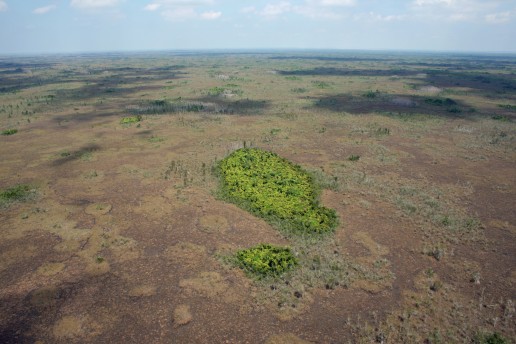
Everglades tree islands don’t just add an air of mystery to this ecosystem. They enhance its unique beauty as well as its elevation, and also provide homes to countless animals. Taking a private airboat tour at Mack’s Fish Camp can give you the chance to see them up close!
Colorful and Creepy Crawly: Everglades Insects
They can crawl, fly and even swim. Some of them look strange, some of them beautiful, and there is a variety of Everglades insects you’ll see when you visit Mack’s Fish Camp in South Florida.
While there are large animals in the Everglades that are better known, like the American alligator and the manatee, we can’t overlook these little guys. Insects play a big role in the Everglades ecosystem, which stretches over many different habitats.
As a link in the Everglades food web, insects are not only a food source for fish, reptiles and amphibians. They also act as pest control for Everglades plants by eating other insects as well as helping with pollination.
Butterflies
There are nearly 100 different butterfly species in the Florida Everglades, a diversity as incredible as their many patterns and colors. Most butterflies are diurnal, so they’re easily spotted during the daytime. Butterflies are very mobile, choosing where they live based upon available resources.
Some species prefer specific types of host plants to rest in, like the ruddy daggerwing. It prefers strangler figs, wild banyan trees, and common figs or their host plants.
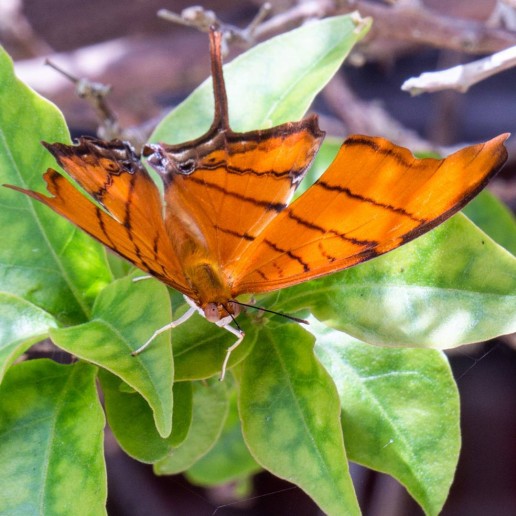
Whirligig Beetles
While you’re on an airboat ride at Mack’s Fish Camp, you might notice what looks like bubbles zipping around in circles on the water. They’re actually whirligig beetles, aquatic insects that dwell on water surfaces.
Whirligig beetles have divided eyes that can see above and under the water at the same time! If threatened, they can dive underwater and stay submerged because of a small air bubble they trap between themselves and the surface.
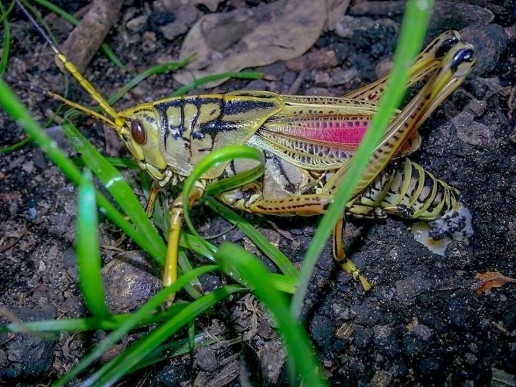
Lubber Grasshoppers
Proof that not all colorful Everglades insects move gracefully through the air, the lubber grasshopper is easy to spot. They sport bright greens and yellows with hints of red, and grow up to 3 inches in length. Lubber grasshoppers get around by jumping and walking, but they’re not very quick. So, you could easily snap a good picture of one should it cross your path.
You might think the lubber grasshopper is an easy target for predators, given its bright colors and slow movement. But, they are very toxic to eat and their vivid colors act as a warning to discourage anything from trying!
Mosquitoes
The most well-known, and infamous of Everglades insects is the mosquito. Despite being a pest to humans, they are arguably the most important insect in the Everglades food web.
By laying their eggs and dwelling near water, mosquitoes are a vital food source to fish, frogs, lizards, and other insects. They are most abundant during the wet season, but their numbers drop sharply in the cool, dry winter months.
They may not be the first sort of Everglades wildlife you hope to see when you visit the River of Grass. But, insects are as much a part of Everglades ecosystems as egrets and alligators. Even if creepy crawlies aren’t your thing, they can still be a pretty sight to behold!
Types of Everglades Reptiles You'll see on an Airboat Ride
A lot of cold-blooded creatures love being in the subtropical climate of South Florida, and it’s not just the tourists. More than 50 different species of reptile live in the Florida Everglades. Reptiles are among some of the most well-known animals found here, and come in a variety of colors, shapes and sizes.
On a private airboat tour at Mack’s Fish Camp, you’re likely to see several of these Everglades reptiles. Here are the different types of them that call the Everglades home.
Turtles
These shelled reptiles can be found swimming in freshwater marshes and swamps, or basking in the Florida sun near water. The most common turtle species in the Everglades is the striped mud turtle. It can be identified by the three yellow stripes that run down its back and stripes on its face.
The Florida soft-shelled turtle is a more unique species, having a long neck and snorkel-like nose. The only time you’ll spot one on land is when they lay their eggs, as they spend almost all of their time in water.
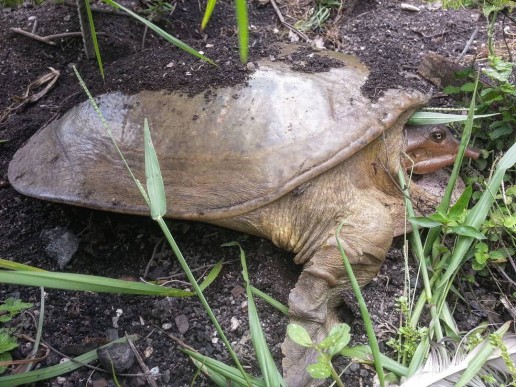
Crocodilians
Being the order of reptiles that alligators and crocodiles belong to, that makes them the most popular of Everglades reptiles by default. Crocodilians are defined as being predatory, semi-aquatic reptiles. As you can imagine, the Florida Everglades is a paradise to them, and they are the kings of it!
While crocodiles prefer the saltwater portions of the Everglades, alligators can be found floating in freshwater marshes or basking in the sunshine. Crocodilians sun themselves to regulate their body temperature.
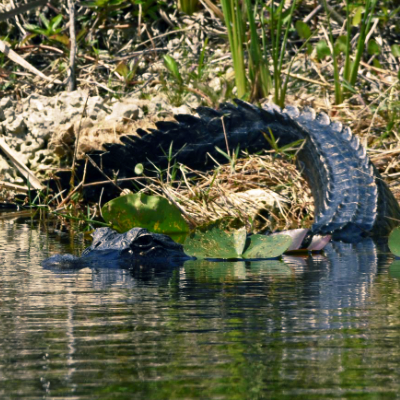
Snakes
Second only to mosquitoes, Everglades snakes are the least-liked creatures here, and perhaps even more misunderstood. All of them are shy and not aggressive unless threatened or disturbed, even the venomous ones.
There are only 4 species of venomous snakes out of the nearly 30 species found in the Everglades. Venomous snakes like the Cottonmouth and non-venomous ones like the red rat snake help manage the Everglades rodent populations. Their shyness and camouflage patterns let them hide in sawgrass marshes and even in the trees of hardwood hammocks.
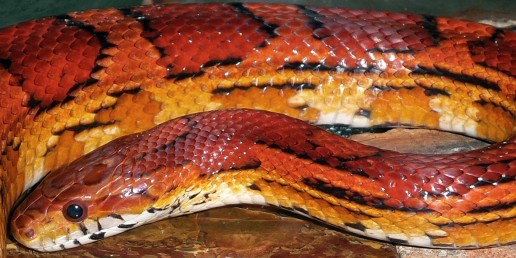
Lizards
We can’t leave out these (mostly) little guys. They may not be intimidating dinosaurs like alligators, but there are nearly 20 lizard species in the Everglades. So they have strength in numbers. Green anoles and their nonnative cousins the brown anole can be spotted in trees by their bright red throat pouches.
Their much larger, invasive cousin, the knight anole, is often found on tree trunks hunting insects and other anoles. Despite being around 18 inches in length, knight anoles can camouflage themselves well. However, they can be spotted by the yellow flash marks under their eyes.
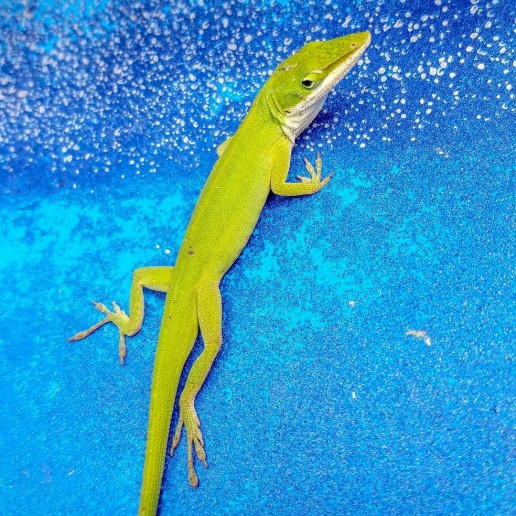
The biodiversity of the Florida Everglades is one of its most cherished traits. Everglades reptiles big and small reside in this ecosystem, beside the many wading birds and among the different habitats. The Everglades can appear so massive on an airboat ride that it can be easy to overlook the little things. If that happens, then look closer, because those little things may just be great at hiding.
Marjory Stoneman Douglas: Defender of The Everglades
You may know that the Florida Everglades spans over 2 million acres. But did you know that it was once over 11 million acres in size?
That remaining 2 million acres is there thanks in large part to the efforts of Marjory Stoneman Douglas.
After publishing her famous book, “Everglades: River of Grass”, she worked to raise awareness of the Everglades ecosystem. She also pushed back against development in the Everglades, and devoted much of her 108 years to protecting it.
Arrival in Miami
Born April 4, 1880 in Minneapolis, Minnesota, a short and ill-fated marriage got Marjory to reunite with her father in Miami in 1915. Her father was the founding publisher at the Miami’s first newspaper, known today as The Miami Herald. She served in the Navy Reserve during World War I, and was the first woman in Miami to enlist. Marjory left the Herald in 1923 and worked as a freelance writer, which lead to the writing of her most famous work.
The Everglades: River of Grass
While working as a freelance writer in the 1940’s, Marjory was approached to write about the Miami River. As she researched the story, she became fascinated with the Everglades and began researching them too!
In 1947, Marjory published “The Everglades: River of Grass” The book details the system of water flow from the Kissimmee River through Lake Okeechobee into the Everglades. Marjory explained that the Everglades wasn’t the swamp that most people though it was, but a slow-moving river!
From Writer to Conservationist
With the attention and support she received upon the publishing of “River of Grass”, Marjory became directly involved with Everglades conservation. She devoted herself to preserving the sheet flow of the Everglades and educating people all over Florida to be aware of its importance. In doing so, she rallied many to Everglades conservation, which lead to the founding of Friends of the Everglades in 1970, which Marjory was the head of.
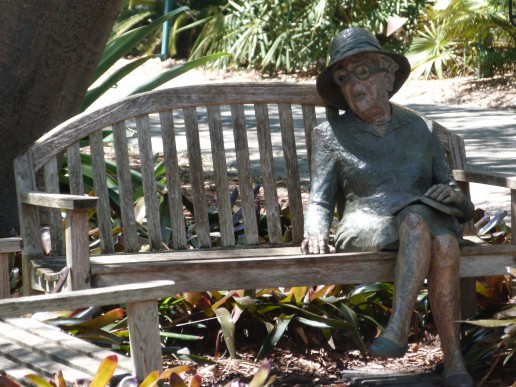
The legacy of the Gladesmen Culture is traditions built upon the marshes and limestone of the Everglades. The passion, commitment, and drive of Marjory Stoneman Douglas forged her legacy, which is the preservation of this ecosystem. Without her tremendous efforts, the Everglades would be just a memory. When you visit Mack’s Fish Camp, we get to share both of our legacies with you.
4 Reasons Why Burmese Pythons Are Overrunning The Everglades
Where does the third largest living snake in the world sit? If it is in Florida, wherever it wants to.
Burmese pythons have earned a reputation for slithering their way to the top of the Everglades food web since their first sightings in the 1980’s. These massive constrictors have become the most notorious invasive species in South Florida, but why? They likely arrived the way most Everglades invasive species do, being released by pet owners or the exotic animal trade.
So, how is this particular invasive seemingly taking over the Everglades ecosystem?
They Reproduce Quickly
Burmese pythons reach maturity between 18 months and 4 years of age, and females can produce a clutch of 35 to 50 eggs or more. They also have a lifespan that can last up to 25 years. With impressive stats like these, it makes their numbers difficult to track.
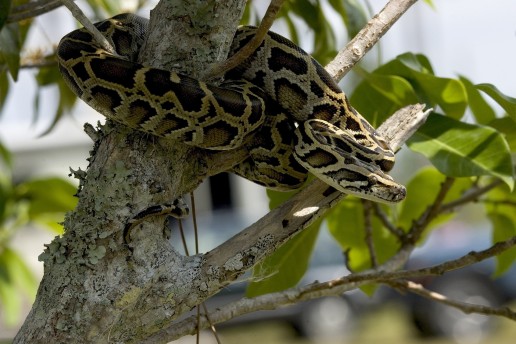
The Everglades Climate is Very Hospitable
There are many invasive species that have adopted the Everglades as their home. Burmese pythons are not only suited for the South Florida climate, but the Everglades ecosystem is like home to them. Originating from the rainy jungles and swamps of southeast Asia, these semi-aquatic creatures are right at home on the River of Grass.
They Are Great At Hiding
By preying on the American alligator, Burmese pythons are now the apex predator of the Everglades. But they have another title that’s helped them thrive as they have: Hide And Seek Champion.
They prefer hiding in underbrush or in holes near rivers, and are also great swimmers. In addition to being able to camouflage themselves, they’re nocturnal. So, their numbers are harder to accurately track, because most recorded sightings are made during the day.
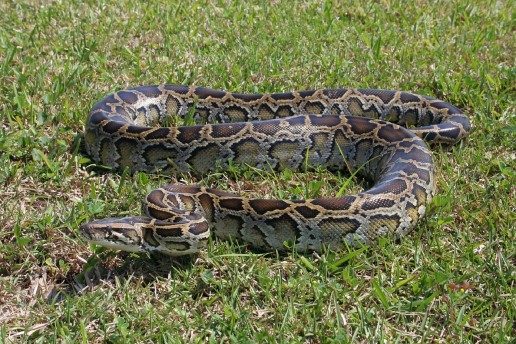
They Are Opportunistic Eaters
You would consider a guest that can eat anything as not being a picky eater. But, if that guest starts eating everything they can, you’d have only your own words to eat. Burmese Pythons have been found to eat a wide variety of Everglades wildlife, including rodents, bobcats, deer, and even alligators!
Their big appetites have like to a steep decline in sightings of rabbits, raccoons, and possums. Because of this, it’s earned the nickname “The snake that’s eating the Everglades”.
South Florida may never be fully rid of these pythons. But, it’s possible that through implementing practical and effective control methods that their population could be managed someday.
When you go for an airboat ride at Mack’s Fish Camp, hopefully you don’t see this Everglades invasive species. While they are shy as most snakes, it could mean trouble for other Everglades wildlife.
5 Surprising Facts About Alligators
Alligators may not be colorful like herons, or be cute and small like green tree frogs. But the power, agility, and strong presence they display in the wild fascinate both locals and Everglades visitors alike. Taking an airboat eco tour, you can learn many interesting things about Everglades alligators. For now, here are a few things you might not know about these living dinosaurs.
They Can Jump… and Climb!
In addition to being nimble swimmers, alligators can jump six feet into the sir from a resting position! This leaping ability is mostly for ambushing prey near the water. But they can use it to grab onto tree branches and climb to their prey.
Having that much mobility could mean one of the most dangerous places to be is between an alligator and a meal. Don’t worry, though. They have a natural fear of people, which is fortunate because…
Alligators are Fast Runners
Alligators prefer to stay in or near water, and their strong tails help them swim at a speed of up to 20 to 30 miles per hour (MPH). But if they see a potential meal hanging out near the edge of the water, they can bolt after it on land. As big and heavy as they are, alligators are capable of moving in short bursts up to 15 MPH on land.
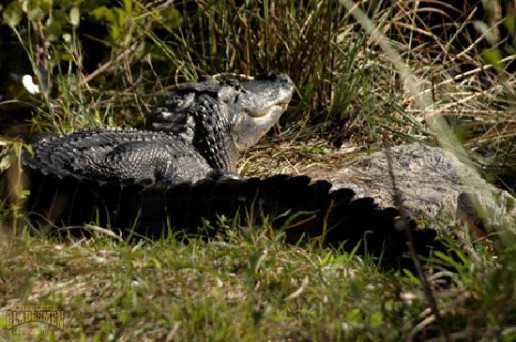
The Sex of an Alligator is Determined by the Temperature of its Nest
Like some reptiles, the temperature of an alligator’s nest determines whether the alligators will be male or female. A temperature below 82.4 degrees Fahrenheit will produce females, and a temperature above 91.4 degrees Fahrenheit will produce males. An even number of both males and females will be produced if the temperature is near 87.8 degrees Fahrenheit.
They Help Maintain the Everglades Ecosystem
Despite their beastly hunting instincts and solitary nature, Everglades alligators give back to their community, whether they realize it nor not. In fact, that solitary nature helps other Everglades wildlife thrive.
When alligators make their homes, called alligator holes, they clear old vegetation away in the marsh. This makes room, for new growth after they abandon their dwelling. Abandoned alligator holes also serve as an oasis to birds and fish during the Everglades dry season, when water becomes scarce.

Everglades alligators are not only the most iconic of all the animals here, but the most significant. While they are wild animals and formidable predators, their shyness around humans makes them perfectly safe to view on an Everglades airboat tour.
Just don’t feed them, or even your running shoes might not save you


